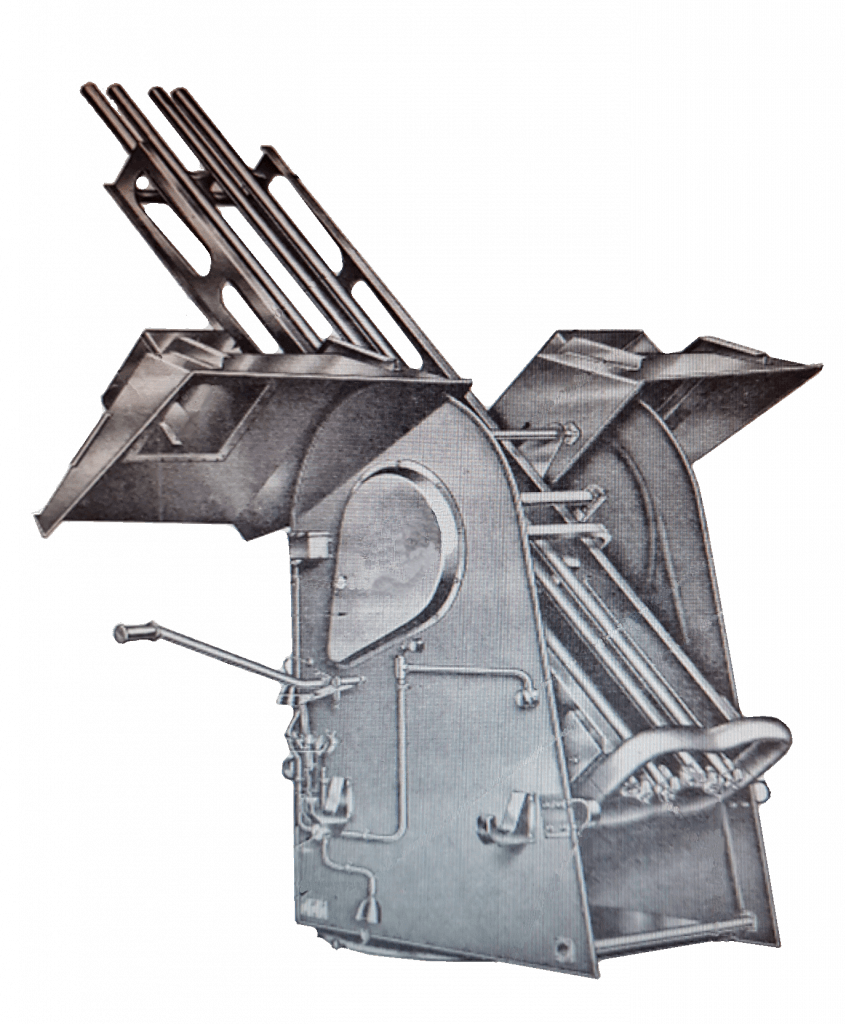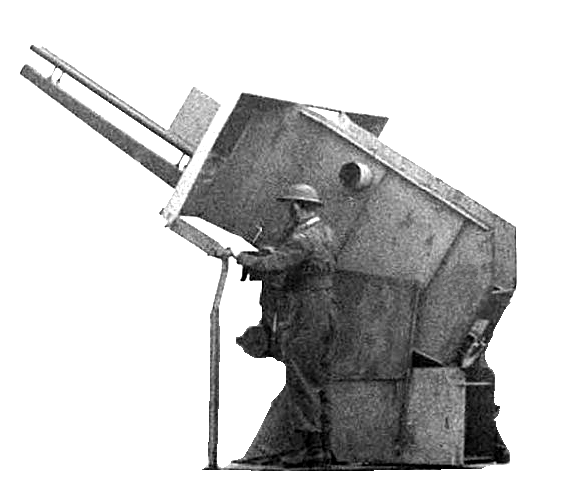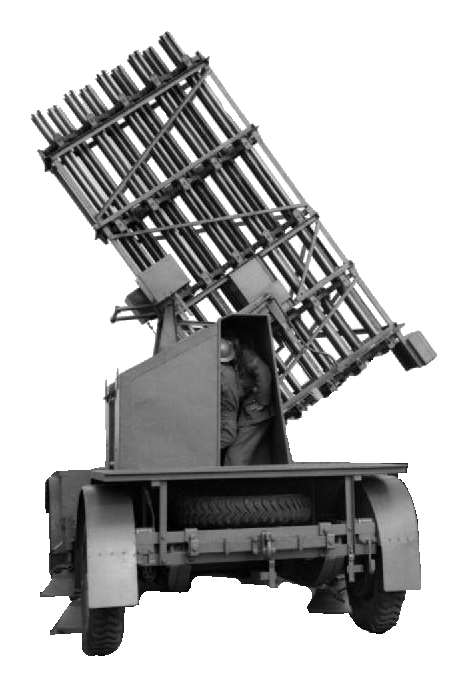
The Projector 3 inch (Z Battery) fired a 3 inch, solid fuel rocket and was developed in the late 1930’s. The rocket was known as the UP-3 (Unrotated Projectile) and was initially developed for the Royal Navy. The Army took an interest, however a decision to introduce it into service was postponed. The Director of Artillery decided it lacked accuracy for medium and high level fire. In June 1940 the project was resurrected and by October an experimental Battery had been set up near Cardiff.
The equipment was approved for service and the first Batteries equipped with single rocket launchers. It was soon realised that the rocket was not as accurate as the initial trials had suggested and a twin launcher was introduced to enable salvos to be fired. This was followed by a 9 rocket version and finally a 20 rocket version. By early 1942, manning of the Z Batteries started to be handed over to the Home Guard. Those men manning conventional Anti-Aircraft guns and Coast Batteries were limited to a maximum age of 40 years. Because of the lighter rockets over shells, Home Guard men could serve in the Z Batteries until age 60. Both the No.2 and No.4 equipments saw service overseas.
Projector, 3-inch Mk 1

It fired a single rocket from two rails using a simple sighting system. The right hand layer pushed the launcher on to the target and the left layer locked the launcher before firing using electrical igntion.
| Rails | 144 inches (370 cm) |
| Weight (approx) | 112 lbs (51 Kg) |
| Height (rails depressed) | 88 inches (220 cm ) |
| Width | 93.3 inches (237 cm) |
| Elevation | 0º to 70º |
| Traverse | 360º |
| Detachment | 2 |
| Projectors per Battery | 64 |
Projector, rocket, 3-inch No.2 Mk 1

It fired two rockets from two rails each. The right hand layer set the elevation using a handwheel and the left hand layer used a crank handle to traverse the mounting. The rockets were launched by electrical ignition from a battery. The launcher could be mounted on a concrete base or on a No.2 firing platform.
| Rails, long | 144 inches (370 cm) |
| Weight | 1.247 lbs (566 Kg) |
| Height (rails up) | 155 inches (300 cm) |
| Width | 107.2 inches (272 cm) |
| Legth | 147 inches (370 cm) |
| Elevation | 10º to 80º |
| Traverse | 360º |
| Detachment | 2 |
| Projectors per Battery | 64 |
Projector, rocket, 3-inch No.4 Mk 1 and 2

The No.4 Projector fired 9 rockets each from two long and two short rails. It was designed for mobile use and was mounted on a trailer derived from the 3 inch Anti-Aircraft Gun mounting. The only difference between the two Marks was that the Mk 2 had an electro-magnetic fuze setter. The two layers were in metal cabins on either side of the bank of rockets. The rockets could be fired in 0.75 seconds or fired in salvoes of 3, 2, 2 and 2.
| Rails, long | 144 inches (370 cm) |
| Rails, short | 84 inches (210 cm) |
| Weight | 16,520 lbs (7,490 Kg) |
| Width | 97 inches (250 cm) |
| Length | 280.5 inches (712 cm) |
| Height (travelling) | 153 inches (390 cm) |
| Height (rails up) | 216 inches (550 cm) |
| Elevation | 7º to 75º |
| Traverse | 360º |
| Detachment | 7 |
| Projectors per Battery | 12 |
Projector, rocket, 3-inch No.6 Mk 1
The No.6 Projector fired 20 rockets in two banks of 10. It was a static equipment and entered service in 1944. The layers sat one behind the other in a central cabin between the two banks of rockets. The elevation layer sat at the front with a window and simple sights. The traverse layer sat behind him with a window in the roof and simple sights. Both were in contact with the Command Post.
The 20 rockets could be fired in 0.75 seconds or in salvoes of 6, 4, 6 and 4. A 7.2 volt battery provided ignition via a foot pedal.
| Rails | 143 inches (360 cm) |
| Weight | 15,680 lbs (7,110 Kg) |
| Width | 126 inches (320 cm) |
| Width, Cabin | 33 inches (84 cm) |
| Length at 20º elevation | 186 inches (470 cm) |
| Length at 80º elevation | 99 inches (250 cm) |
| Height at 20º elevation | 156 inches (400 cm) |
| Height at 80º elevation | 189 inches (480 cm) |
| Elevation | 20º to 80º |
| Traverse | 345º |
| Detachment | 10 |
